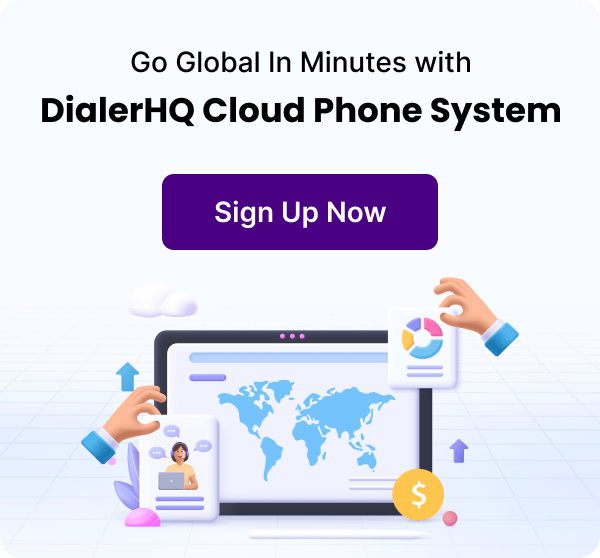Senior Writer: Paras Kela
Call routing, a fundamental component of modern telecommunications and customer service strategies, plays a pivotal role in ensuring that calls are directed to the right individuals or departments, enhancing customer satisfaction, and streamlining operations.
83% of customers expect to engage with the right agent immediately when contacting a company. This makes call routing even more crucial as it directly impacts customer satisfaction.
So, let’s learn more about call routing. This comprehensive guide explores the intricacies of call routing, delving into its various types, best practices, and the significant benefits it brings to businesses. Let’s dive in!
What is Call Routing?
Call routing is a call management feature and telecommunication process that determines the path an incoming call should take to reach its intended recipient or destination within a phone network.

It is like the traffic management system of a phone system, ensuring that calls are directed to the right destination, whether it’s an individual, a department, or an automated call routing system, like an IVR system.
Call routing software can be implemented in various ways using call management features and can be highly customized to meet the specific needs of an organization. It is a crucial component of call centers, customer support hotlines, and businesses of all sizes, as it helps in efficiently handling large volumes of incoming calls.
How Does Call Routing Work?
Call routing is a telecommunications process that efficiently directs incoming calls to their intended destinations within a phone network. This system follows a series of predefined rules and criteria to make real-time decisions about where a call should be directed. These criteria may include the dialed number, time of day, caller’s location, agent availability, and caller history.

Once these factors are considered, the phone routing system decides whether to connect the caller to a specific department, an Interactive Voice Response (IVR) system, or a queue with recorded messages.
A queue with recorded messages is a system that plays pre-recorded messages to callers while they are waiting for an agent to become available. These messages can provide information about the company’s products or services, or they can reassure the caller that their call is important and will be answered soon. The call is then connected accordingly, enabling callers to interact with the chosen destination.
You May Also Read : What is Call Queuing? A Complete Guide
VoIP call routing is essential for ensuring that callers are promptly and accurately connected to the right person or department, ultimately enhancing customer satisfaction and optimizing business operations.
What are the Different Types of Call Routing?
Call routing is a versatile system with various methods and approaches to directing incoming calls efficiently. These methods are tailored to meet different business needs and enhance customer service. Here are some of the different types of call routing, each with its unique benefits and applications.

1. Direct Inward Dialing (DID) Routing
DID routing assigns a unique phone number to each individual or department within an organization. When callers dial a specific DID number, they are directly routed to the corresponding destination. This method is useful for businesses with multiple departments or individuals who require personalized access.
2. Time-Based Routing
Time-based intelligent call routing routes calls differently based on the time of day, day of the week, or specific dates. For example, calls during business hours might be directed to live agents, while after-hours calls are sent to voicemail or an emergency support team.
3. Geographic Routing

This type of routing is based on the geographic location of the caller. It can direct callers to the nearest service center or office, improving efficiency and reducing call handling times. Geographic routing is especially beneficial for companies with a national or international presence.
4. Skills-Based Routing
In a skills-based routing system, calls are directed to agents or employees with specific skills or expertise relevant to the caller’s needs. For example, a technical support call might be routed to an agent with expertise in troubleshooting technical issues.
5. Interactive Voice Response (IVR) Routing
IVR systems use automated menus to interact with callers. Callers select options using their phone’s keypad or voice commands, and the IVR system routes them based on their selections. IVR routing is excellent for handling routine inquiries and reducing the workload on live agents.
6. Priority-Based Routing

Priority-based routing assigns levels of importance to calls. High-priority calls, such as urgent customer issues, are routed to the most skilled or available agents first, ensuring critical matters are addressed promptly.
What Are the Benefits of Call Routing?
Implementing call center call routing offers numerous benefits to contact centers, call center agents, and customers. It helps improve operational efficiency and overall effectiveness. Let’s see how!

Benefits of Call Routing for Contact Centers
- Minimizes the number of calls routed to the incorrect team or agent.
- Improves predictive analytics to strike a balance between agent availability and customer call volume.
- Lowers callbacks and customer attrition by raising the first-call resolution rate in your business phone system.
- Reduces cellular expenses by optimizing call handling. For example, if a call is routed to an agent who is not available, the system can automatically redirect the call to the next available agent or voicemail. This reduces the time spent on each call, thereby reducing cellular expenses.
Benefits of Call Routing for Customers
- Reduces wait times to connect with the right department because there are fewer callbacks and repeat calls.
- Promotes access to essential details before joining the phone queue, like business hours and self-service choices.
- Using skills-based or other routing techniques connects consumers with the most competent agent to provide help.
Benefits for Call Center Agents
- The call routing process, when used effectively, can empower call center agents by using preset routing rules to divide calls among team members equitably and effectively.
- Ensures a fair distribution of workload and also recognizes the unique skills and capabilities of each agent, making them feel valued and integral to the process.
- Employs Interactive Voice Response technology to gather caller information when a call comes in.
- Improves client experience by allowing faster, more casual conversations.
What Are the Best Practices of Call Routing?
Call routing is a critical component of a successful customer service strategy. To ensure an efficient and effective call routing system, organizations should adhere to several best practices:

1. Understand Customer Needs
The foundation of an effective call routing system is a deep understanding of your customers’ needs. By analyzing the types of inquiries and issues you typically receive and tailoring your routing rules to address these needs, you demonstrate a customer-centric approach that prioritizes their satisfaction and needs.
2. Customization and Flexibility
Choose a call routing system that offers customization and flexibility. Not all calls are the same, and business needs can change over time. A system that allows you to create and modify routing rules to align with evolving requirements is essential for long-term success.
3. Real-Time Data Utilization

Leverage real-time data to make routing decisions. This data might include agent availability, call volume, and customer history. Real-time decision-making ensures that calls are directed to the most appropriate destination at any given moment, improving efficiency.
4. Regular Monitoring and Optimization
Continuously monitor the performance of your call routing system. Collect feedback from customers and agents to identify areas for improvement.
Regularly review key metrics such as call abandonment rates, average wait times, and first-call resolution rates. Use this data to optimize your routing strategy.
5. Agent Training
Ensure that your agents are well-trained and equipped with the necessary skills to handle the types of calls they receive.
Effective training not only enhances the customer experience but also improves first-call resolution rates, reducing the need for call transfers.
What Type of Call Routing System is Best?
The choice of the best call routing system depends on the specific needs and objectives of an organization. There is no one-size-fits-all solution, as different businesses have varying customer service requirements.
For organizations dealing with complex inquiries and specialized knowledge, skills-based routing is often the best choice, ensuring that calls are directed to agents with the expertise needed.
On the other hand, time-based routing is ideal for businesses with fluctuating hours, allowing calls to be routed differently during various periods. For those aiming to personalize access for different departments or individuals, direct inward dialing (DID) routing is effective.
So, assess your business needs before investing in a call routing system for your organization.
What Are the Top Call Routing Rules and Strategies?
To reliably route calls to available agents, effective call routing systems include a number of factors. These routing techniques improve the clientele’s experience for companies of all kinds. Common strategies include:

1. Simultaneous Routing
It reduces customer wait time by ringing all available agents simultaneously on inbound calls until one responds.
2. Linear Routing
Calls are routed to agents in a predetermined order, starting with the first available agent. This approach minimizes the number of calls an agent must handle by catering to clients with easier questions that need prompt resolution.
3. Round Robin Routing
Round-robin routing allocates calls across agents in an equitable manner. When there are three agents, for example, the first call is handled by the first available agent, the second by the next, and the third by the next after that. The cycle repeats itself once each agent has been given a call.
4. Alternative Call Routing Methods
Beyond the ones listed here, there are a plethora of more call routing techniques. Calls can be routed to the agent who has recently taken the fewest calls, the agent who has completed the fewest calls, or an agent chosen at random.
Conclusion
Call routing is a crucial element of modern customer service and telecommunications, and its effectiveness can significantly impact an organization’s success.
A well-implemented call routing system streamlines operations and enhances customer satisfaction, leading to higher retention rates, improved brand reputation, and sustainable business growth.
So, choose the best call routing system to gain a competitive advantage and increase results.

Paras Kela is an accomplished IT professional with 7+ years of industry experience, including 4+ years as a dedicated content writer. His expertise lies in crafting informative blogs on VoIP and cloud telephony, among other technical subjects. Outside his professional pursuits, he cherishes quality time with loved ones, indulges in watching documentaries, and finds solace in gardening.
Updated : May 16, 2024

Subscribe to our newsletter & never miss our latest news and promotions.





